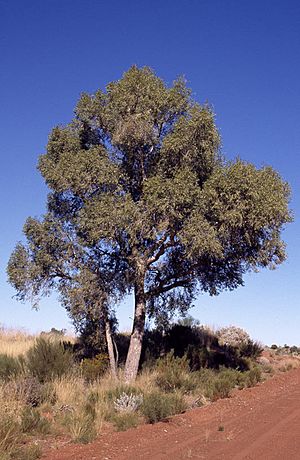Sand-dune bloodwood facts for kids
The Sand-dune bloodwood (scientific name: Corymbia chippendalei) is a special kind of small tree. It's also known as the sandhill bloodwood. This tree is found only in the desert areas of central Australia. It can grow as a single tree or as a "mallee," which means it has many stems growing from a woody base underground. The Sand-dune bloodwood has rough bark on its trunk. Its leaves are shaped like a spear, and its flowers are white, growing in groups of seven. After flowering, it produces round, woody fruits.
Quick facts for kids Sand-dune bloodwood |
|
|---|---|
 |
|
| Eucalyptus chippendalei near Warburton | |
| Scientific classification | |
| Genus: |
Corymbia
|
| Species: |
chippendalei
|
| Synonyms | |
|
Eucalyptus chippendalei D.J.Carr & S.G.M.Carr |
|
Contents
What Does the Sand-dune Bloodwood Look Like?
The Sand-dune bloodwood, also called Eucalyptus chippendalei, is usually a tree that grows up to 10 m (33 ft) tall. Sometimes, it grows as a smaller "mallee." A mallee is a type of plant that has many stems growing from a large, woody underground base called a lignotuber. This lignotuber helps the plant survive fires and dry times.
The tree has rough bark on some or all of its trunk. This bark can be flaky or look like a puzzle (tessellated). Higher up on the tree, the bark is smooth and can be cream-colored or white.
Leaves
Young Sand-dune bloodwood plants and new shoots (called coppice regrowth) have long, narrow, spear-shaped leaves. These leaves are usually 50–110 mm (2.0–4.3 in) long and 10–20 mm (0.39–0.79 in) wide. They are "sessile," which means they attach directly to the stem without a stalk.
Adult leaves are shiny green on both sides. They are 80–130 mm (3.1–5.1 in) long and 10–23 mm (0.39–0.91 in) wide. These leaves have a stalk, called a petiole, which is 10–20 mm (0.39–0.79 in) long.
Flowers and Fruit
The flower buds of the Sand-dune bloodwood grow at the ends of the branches. They are arranged on a branched stalk called a peduncle, which is 5–20 mm (0.20–0.79 in) long. Each branch of this stalk holds seven buds. Each bud has its own small stalk, called a pedicel, which is 1–7 mm (0.039–0.276 in) long.
When the buds are ready, they are oval or pear-shaped, about 7–9 mm (0.28–0.35 in) long and 5–7 mm (0.20–0.28 in) wide. They have a rounded or cone-shaped cap called an operculum. This cap protects the flower parts inside.
The Sand-dune bloodwood flowers from January to March, and its flowers are white. After flowering, the tree produces a woody, round fruit. This fruit is a type of capsule that is 16–28 mm (0.63–1.10 in) long and 15–250 mm (0.59–9.84 in) wide. The parts that open to release seeds (called valves) are hidden inside the fruit.
How the Sand-dune Bloodwood Got Its Name
The Sand-dune bloodwood was first officially described in 1985 by two scientists, Denis Carr and Stella Carr. They gave it the name Eucalyptus chippendalei.
Later, in 1995, two other botanists, Ken Hill and Lawrie Johnson, changed its scientific name to Corymbia chippendalei. The second part of the name, chippendalei, was chosen to honor a person named George Chippendale. This is a common way for plants to get their specific names.
Where Does the Sand-dune Bloodwood Grow?
The Sand-dune bloodwood, Corymbia chippendalei, mostly grows on the tops of sand dunes. You can find it in the Great Sandy Desert and the central mountain ranges of eastern Western Australia. It also grows in the southwestern part of the Northern Territory.

